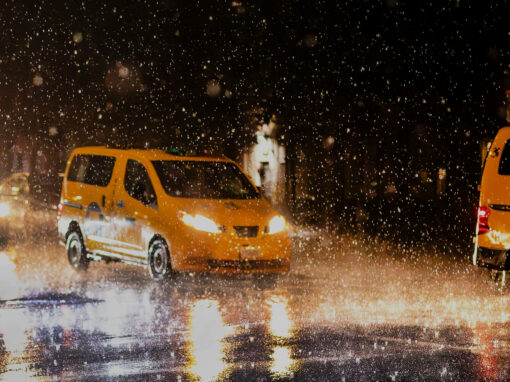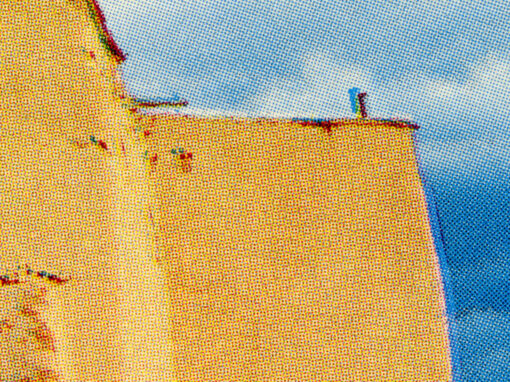Although this may be a matter of taste, I love collections of photography that tell a story.
I don’t mean a simple story with a clear, singular plot line. I mean a multi-faceted, braided narrative, like the very best novels or symphonies, where there is an arc, a development, an idea, comedy or tragedy, love or despair. Photobooks, perhaps more than any other art form because of the potential within a single photograph to imply huge narrative narratives, can become some of the richest storytelling experiences we have available. Documentary Photography is especially an act of storytelling. Here, the genre says, is a place or a community, a person or an idea; let’s follow it through time and space and see where it may go.
“A Falling-Off Place: The Transformation of Lower Manhattan” by Barbara W. Mensch
Published by Empire State Editions/Fordham University Press, 2023
Review by W. Scott Olsen

Within Documentary Photography there is often an element which adds extra depth, too: Retrospective. To be clear, what I mean here is the act when the photographer, older and wiser, gets to revisit work, rethink, reorder, add the wisdom of few or many years to the collection, to allow us to see what we have seen before but never quite understood this way. Documentary Photography can be urgent. After some time, it can also be wise.
I have on my desk today a book which, frankly, I love. It’s called A Falling-Off Place: The Transformation of Lower Manhattan. The work is by Barbara Mensch, whose photography I have admired for some time. The book is perceptive and insightful and, if it’s possible to join both wisdom and nostalgia into one idea that is neither sentimental nor damning, then this book is that.


Perhaps what I’m trying to say is that this book is an act of love.
The introduction begins with an explanation of how this book came to be. Mensch writes about waking up in June of 2020. Politics had gone more than usually insane. COVID was keeping everybody indoors. Any sense of any sense was missing from the world. She writes—
I woke up to another day of apprehension…To fight against these dispiriting thoughts, I would go on a journey back in time.
Reflexively, I stared up at the storage area above my dark room. Amid construction materials, books, and toys, I was determined to find my early work. Hand-printed photographs, strips of negative film, and folders of typewritten notes were buried beneath other items. The material dated from the 1980s, when I moved to the waterfront in Lower Manhattan. Perhaps looking at this work, I thought, would rescue me from a downward spiral. But why?
It’s an interesting question. Why does looking at history lend itself toward insight about the future? I remember colleagues in the history department of the college where I teach, talking about the history department as a department of activism. You learn about the past to make the best possible future.

Mensch continues—
I then found the unlabeled boxes. Some of the forgotten 8×10 prints were portraits of the men who had worked at the Fulton market. Gazing into my camera, I sensed the subjects’ eerily communicating (to me) their inner truths. Other boxes of photographs contained contact sheets from decades of traversing, again and again, the familiar streets of Lower Manhattan–Chinatown, Tribeca and the Bowery.
I shot ruins of buildings, the demolition of famous waterfront saloons, ancient alleyways, and, in some cases, 19th century buildings destroyed by mysterious fires (and soon after replaced with new developments). The boxes also contained images of floods and other Lower Manhattan calamities and catastrophes, culminating in the 9/11 attack on the World Trade Center. Together, they became my personal visual timeline. What did the passage of decades reveal to me? What dynamics were at play in my images of the same streets that I walked repeatedly for years? What fell off as the old was swept away by the new?

That is the essential question. What remains when what we see changes? What do we hold in our heads and in our hearts?
In a separate forward by Dan Barry, he writes—
There is no longer any scent of what was. Thankfully, though, there’s Barbara Mensch, whose images are like conjuring rain. She is the Brooklyn Bridge of the New York imagination, linking the now and the then. She sees the incremental turns in the city’s inexorable evolution, the obliteration of the past by gentrification, the irreversible domination of profit over preservation.
A Falling-Off Place begins with an image from 1980 under the FDR Drive. We can see the Fourth Ward buildings already decaying. This is followed by a picture of the last days of the Paris bar, then Front Street, the fish market and so on. It is a lower Manhattan well known to anybody over the age of 60 who had the good fortune or misfortune to visit there. It is also the lower Manhattan of tremendous stories: crime, the economy of fish, the definition of a city.

Every image in Mensch’s catalog is an act of illumination, an act of revealing insight. The images are black and white, the large majority of them square, center-weighted with their composition. The images are not so far in the past that the people are unfamiliar, or so far away that we don’t feel a connection. As the book goes on, we see that the demolition of the Lower East Side, its renovation into a different affluence, the bits of arson to help the process along. We see grappling hooks and loading docks, the 9/11 attack and Hurricane Sandy.
I have the good fortune to know the Lower East Side, although my knowledge there is no deeper than a tourist’s knowledge, even though my visits began in the mid-1970s. I look at these images and I recognize them. But taken together, what this book offers what my brief visits never could—a gathered understanding to, as the subtitle says, the transformation of lower Manhattan.


Barbara Mensch is a talented photographer. It doesn’t really matter whether she’s using a Rolleiflex or a cell phone. Her eye not only for what we would consider artful composition, but her eye for insight, her eye for those moments that reveal something about the character of person and place, is extraordinary. To look at images where she photographs remnants of a sales floor, the new market building, peeling walls, or the rigging used to demolish the new market building, is to realize she’s one of the very few of us who photographs character: character of place, character of person, character of community.
This book presents a history of a part of Manhattan, as well as a history of encounter with an artist’s eye, a local’s knowledge and a sense of belonging. Whether you know New York or not, this book will give you the wisdom of perspective through art.

A note from FRAMES: Please let us know if you have an upcoming or recently published photography book.




